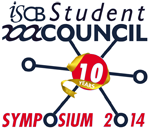Special Talks - ISMB 2014
Attention Conference Presenters - please review the Speaker Information Page available here
Presenter: Lynn Kamerlin
Room: 302
Date/Time: Sunday, July 13 at 11:30 a.m. - 11:55 p.m.
Session Chair: Bonnie Berger
The advent of the first enzyme structures in the 1960s, coupled to increasing computer power at the time, marked a turning point for computational enzymology. Specifically, starting in 1970, a number of different QM+MM and QM/MM approaches were introduced by Warshel and coworkers to facilitate the description of reactions in enzymes. This and molecular dynamics simulations of biological reactions (that also started with Warshel’s work), as well as the development of classical force fields, mark the emergence of multiscale models for chemical reactivity, that allowed us to begin to directly translate structural information into an energetic picture, to better understand enzyme function. In my view the most effective direction to address this problem has been the Warshel’s 1980s “empirical valence bond” approach. Despite its seemingly theoretical simplicity, the empirical valence bond approach remains one of the most powerful tools to understand chemical reactivity in biological systems even today. This talk will explore the theoretical basis and historical background for this approach, and illustrate its application to a number of the most challenging problems in computational enzymology. Additionally, the unimaginable gains in computational power of recent decades have allowed for ever more complex systems to be addressed. Therefore, this talk will conclude by discussing the power of the EVB approach to address 21st Century challenges such as enzyme design, understanding protein evolution, and addressing chemical reactivity in even such big biomolecular systems as GTP hydrolysis on the ribosome.
Presenter: Roland Dunbrack
Room: 302
Date/Time: Sunday, July 13, 12:00 p.m. - 12:25 p.m.
Session Chair: Bonnie Berger
In September of 1981, as a freshman at Harvard College, my first class on my first day of college was Martin’s Chemistry 10 course. Over the next four months, Martin proceeded to teach the outline of his influential textbook Atoms and Molecules to freshmen in what was the upper-level intro freshman chemistry course (the other was Chemistry 5 taught by Leonard Nash, who Martin had taken his intro course in chemistry from in 1947). Martin started with the quantum mechanical model of a particle in a box, then one-electron atoms, two-electron atoms, many electron atoms, the hydrogen molecule, other diatomics, triatomics, and the H+H2 reaction. The last lecture of the course he showed a movie of the one of the first molecular dynamics simulations of a protein structure, BPTI. I was astonished that this was possible, and I was hooked by the prospect of being able to understand so much of biology with theoretical and empirical chemistry and physics. I was able to work for him on quantum mechanical treatments of polyenes as an undergraduate and after finally learning some biochemistry at Cambridge after graduating from Harvard in 1985, returned to Harvard for a PhD in biophysics split between Martin and Jack Strominger in the Biochemistry Department. My work in grad school and ever since has been on the statistical end of things, but the motivation as was often the case in Martin’s work, was to solve a biological problem – initially the structure prediction of the many variants of HLA Class I proteins whose first structure was solved in 1987 by Don Wiley and Jack Strominger. I proposed and developed the backbone-dependent rotamer library as a statistical way of solving the side-chain conformation prediction problem for HLA proteins and proteins in general. It remains a central component of many if not most structure prediction and protein design programs. From Martin I learned how important it is to interpret and understand the statistical results in terms of the underlying physical forces. Just as important, I learned how to write up our work in sufficient detail that it can be replicated. I can still hear his voice in my head when I am writing papers, asking me to fill in some important detail to make everything crystal clear and reproducible. For better or worse, I still tend to write long papers because of this. In this talk, I will review our work on statistical functions of the Ramachandran map variables – density estimates, classification functions, and finally regression functions on the Ramachandran variables. Our recent regressions of bond angles of the main chain and side chains in very high-resolution structures (better than 1.0 Å) have identified aspects of current potentials that accurately reflect the high-resolution structures and areas for further improvement – indicating that some physical properties of proteins are not yet accurately modeled by current empirical force fields used in CHARMM and other programs.


